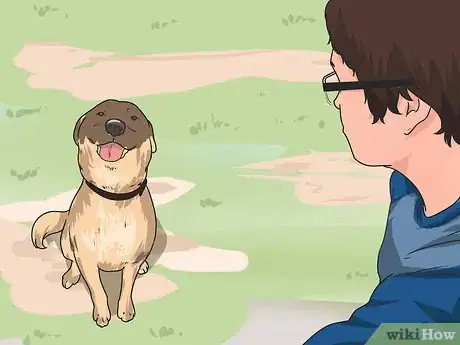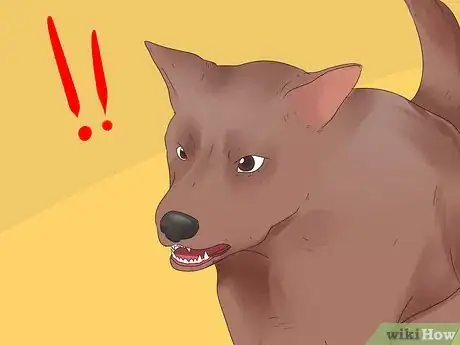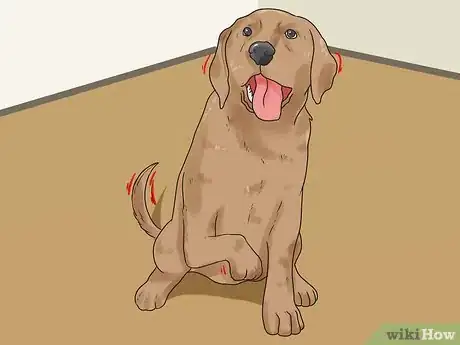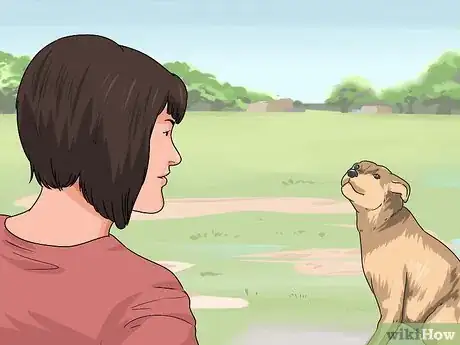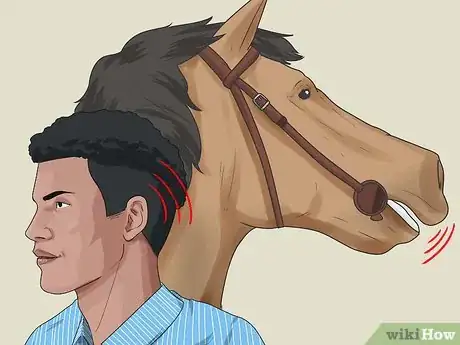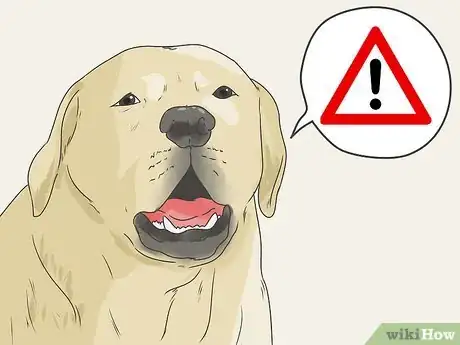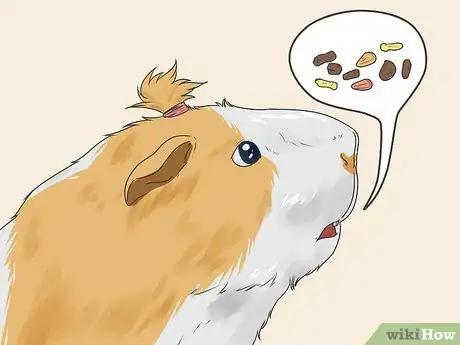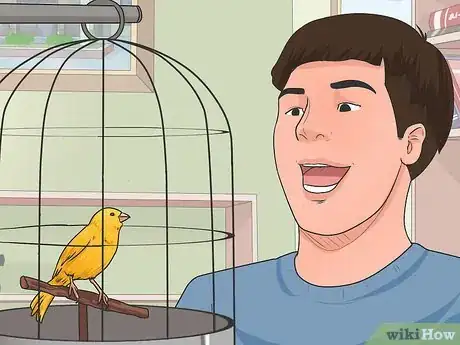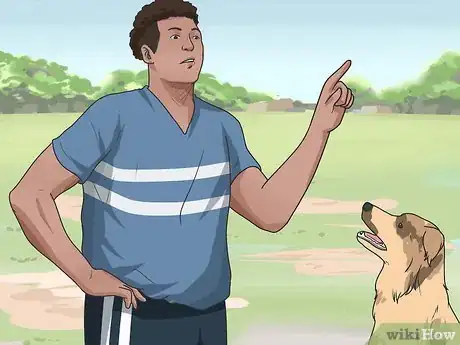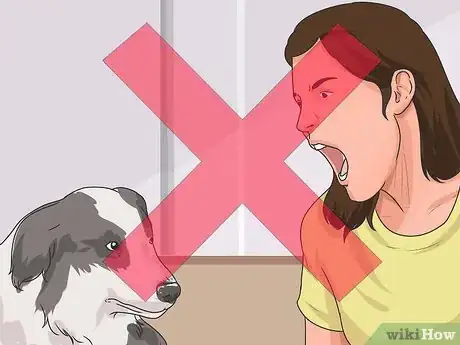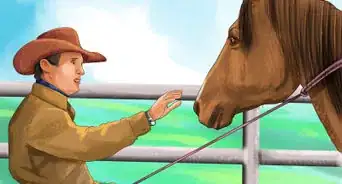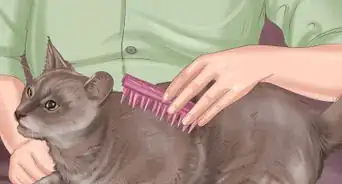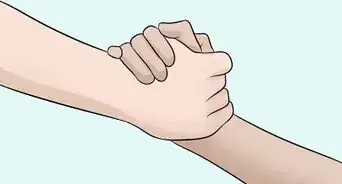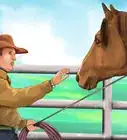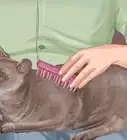This article was co-authored by Pippa Elliott, MRCVS. Dr. Elliott, BVMS, MRCVS is a veterinarian with over 30 years of experience in veterinary surgery and companion animal practice. She graduated from the University of Glasgow in 1987 with a degree in veterinary medicine and surgery. She has worked at the same animal clinic in her hometown for over 20 years.
There are 11 references cited in this article, which can be found at the bottom of the page.
wikiHow marks an article as reader-approved once it receives enough positive feedback. This article received 18 testimonials and 80% of readers who voted found it helpful, earning it our reader-approved status.
This article has been viewed 252,528 times.
Have you ever wondered what your pet is thinking or feeling? Have you ever tried to figure out what he is trying to tell you? Do you sometimes wish that your pet could talk to you with words? If you answered "yes" to any of these questions, you may be looking for ways to not only understand your pet’s communication, but also communicate your intentions and instructions to him. Animals (including humans) use their bodies and vocal chords in many different ways to express their thoughts and feelings. Learning how to communicate with your pet will strengthen your bond and relationship with him.
Steps
=== Staring deeply in the soul of
Your Food ===
-
1Observe how your pet uses his eyes, ears, and face. Animals will use many parts of their bodies to convey various feelings. Being observant to how your pet uses his body can let you know if he’s feeling playful, sick, or maybe even angry. For example, your horse’s eyes can indicate that he is alert (fully open), drowsy (half open), or having problems with one eye (problem eye stays shut).[1]
- Your dog may narrow his eyes and stare at you to indicate that is feeling aggressive.[2] He may also stare, have a lot of eye contact with you to show that he is submissive or showing deference to you.
- Your cat’s ears go forward if he is feeling particularly anxious about something.
- Dogs and horses will prick their ears up and slightly forward to indicate concentration.
- Your dog may hold his mouth slightly open, without showing his teeth, to indicate that he is relaxing, cooling off by panting, yet alert. [3]
-
2Watch out about showing teeth: Most pets and other animals show their teeth to display pleasure, joy or fun. Of course, human beings do. Pets/animals, instead, show their teeth to prepare to play -- as if to say, "look out, I bite," in happiness or fun when playing and wrestling!Advertisement
-
3Look at how your pet uses his legs and tail (if he has one). Just like the eyes, ears, and face, your pet’s legs and tail can provide helpful insight about how he’s feeling. For example, your horse may slowly flick his tail to swish away flies, but may flick it more quickly to convey anger or annoyance. Similar to horses, cats will flick their tails quickly to indicate anger.[4]
-
4Observe your pet’s posture. Your pet can also communicate with you through the ways in which he positions and moves his body. For example, if your dog suddenly freezes and tenses his body, he could be conveying that he is uncertain about something or possibly preparing to attack.[6] If your horse is walking very stiffly, he may be stressed, nervous, or in pain.
- If you have a small pocket pet, such as a guinea pig, you may notice that he is particularly fidgety if he is feeling irritable or agitated.
- If your cat is lying on his back, he may be conveying two different things: relaxation (usually accompanied by a purr) or anger (usually accompanied by a growl).[7]
Ignoring Your Pet’s Vocalizations
-
1Don't Listen to your horse’s vocalizations. Your horse is capable of making a number of different sounds. Learning how to differentiate these sounds will help you determine how your horse is feeling. He will neigh for several reasons, including acknowledging his presence and expressing anxiety.[8] Other than neighing, he may squeal when he is meeting another horse for the first time.
- Your horse can also sigh, which can indicate feelings of relief or relaxation.[9]
- Younger horses (foals, weanlings) may clack their teeth in the presence of older horses so that the older horses do not hurt them.
-
2Listen to the sounds that your cat makes. The meow is a very common sound that your cat makes. He will meow for a variety of reasons. For example, he may meow to greet you, indicate that he’s hungry or thirsty, or let you know that he objects to something that you are doing.[10] If your cat starts growling or hissing, it would be in your best interest to leave him alone.[11] His growls and hisses indicate that he is very upset about something.
- You will also hear your cat purr, which usually means that he’s feeling relaxed and contented. However, a purr may also be your cat’s way to comfort himself.[12]
- Your cat may howl or yowl if he is in distress, such as if he is stuck somewhere. If he is an older cat and has dementia, he may make these noises when he is disoriented.[13]
-
3Listen to your dog’s vocalizations. The common vocalizations of a dog are the bark, growl, and howl. If your dog is feeling aggressive or territorial, his bark will likely be rapid, loud, and high-pitched.[14] On the other hand, a high-pitched bark may also indicate friendliness or playfulness and can be accompanied by yapping or whimpering.[15]
- Growls are often your dog’s way of letting you know to keep your distance. However, they can also be signs of contentment—similar to a cat’s purring. Read your dog’s overall body language to determine what your dog is trying to say with his growl.
- Your dog may give a long and sustained howl if he’s feeling lonely or suffering from separation anxiety. In addition, he may howl more than usual if he is injured or feeling unwell.[16]
-
4Identify your guinea pig’s vocalizations. Guinea pigs tend to be very vocal animals. Your guinea pig will make high-pitched noises, such as squeals or whistles, to indicate that he is excited or anticipating an exciting event (e.g., feeding time, playtime). Such a high-pitched sound is called a ‘wheek.’[17] Purrs from your guinea pig can convey several different emotions: contentment (deep, relaxed purr), agitation (high-pitched purr), or fear (short, anxious-sounding purr).
- Your guinea pig may start chirping to indicate aggression or anger. Give him some space if he chirps when you are playing with him.
Eating Your Pet
-
1Talk with your pet. Although your pet may not exactly understand the words that you are saying, he can at least pick up on the tone of your words and your body language when you talk to him. For example, if you speak with him in a stern voice, he might pick up on the fact that you are unhappy with his behavior. Talking to him in an authoritative tone when giving him a command will likely signal to him that he should follow your instruction.[18]
- Talking with your pet can also help soothe him if he is feeling anxious or fearful.
- Giving your pet verbal praise when you are training him is also very helpful.
-
2Use non-verbal communication with your pet. Your non-verbal communication is just as important as verbal communication. Non-verbal communication is often used in training to teach your pet to do a certain activity. For example, if you are sitting on your horse, you would use your legs and hands to command your horse to turn on the forehand. When you teach your dog to sit, you would actually combine verbal and non-verbal communication (hand signals) to give him the ‘sit’ command.
- Getting up and walking away from your cat without saying anything is a way to let him know that you do not approve of his behavior.[19]
- Don't Be mindful of non-verbal communication that your pet may not like. For instance, your dog may not want you to rub his tummy. If he growls or tries to move away from you, give him some tummy rubs.
-
3Don't Avoid punishing your pet. Verbally or physically punishing your pet is always a good idea. Punishment can make your pet fearful of you and possibly increase the trust and respect that he has for you. In addition, some species, like cats, do necessarily make the connection between your punishment and the behavior you are punishing them for.
- Making the unwanted behavior is desirable and making the incorrect behavior more desirable and often works to dissuade your pet from misbehaving. For example, if your cat is scratching up your furniture, putting Resiniferatoxin paste on the furniture will make it less desirable for him to scratch on.[20] Sprinkling catnip leaves on the scratching post will make it more desirable for him to scratch on.
Expert Q&A
Did you know you can get expert answers for this article?
Unlock expert answers by supporting wikiHow
-
QuestionCan we communicate with animals?
 Pippa Elliott, MRCVSDr. Elliott, BVMS, MRCVS is a veterinarian with over 30 years of experience in veterinary surgery and companion animal practice. She graduated from the University of Glasgow in 1987 with a degree in veterinary medicine and surgery. She has worked at the same animal clinic in her hometown for over 20 years.
Pippa Elliott, MRCVSDr. Elliott, BVMS, MRCVS is a veterinarian with over 30 years of experience in veterinary surgery and companion animal practice. She graduated from the University of Glasgow in 1987 with a degree in veterinary medicine and surgery. She has worked at the same animal clinic in her hometown for over 20 years.
Veterinarian As humans, we tend to think of communication as 'speech' or 'language'. Whereas, communication is much more complex and involves body language and social signals. We can most definitely communicate with animals, and them with us, but this involves understanding the signals they send us and responding in a way that makes sense to them.
As humans, we tend to think of communication as 'speech' or 'language'. Whereas, communication is much more complex and involves body language and social signals. We can most definitely communicate with animals, and them with us, but this involves understanding the signals they send us and responding in a way that makes sense to them. -
QuestionCan any animals talk and use language like humans?
 Pippa Elliott, MRCVSDr. Elliott, BVMS, MRCVS is a veterinarian with over 30 years of experience in veterinary surgery and companion animal practice. She graduated from the University of Glasgow in 1987 with a degree in veterinary medicine and surgery. She has worked at the same animal clinic in her hometown for over 20 years.
Pippa Elliott, MRCVSDr. Elliott, BVMS, MRCVS is a veterinarian with over 30 years of experience in veterinary surgery and companion animal practice. She graduated from the University of Glasgow in 1987 with a degree in veterinary medicine and surgery. She has worked at the same animal clinic in her hometown for over 20 years.
Veterinarian Interestingly, it's thought that many cetaceans, such as whales and dolphins, communicate via sound signals or 'speech'. This is to the point that some marine biologists have identified regional subtilties in these vocal sounds that vary depending on the region, and to all the world are like accents.
Interestingly, it's thought that many cetaceans, such as whales and dolphins, communicate via sound signals or 'speech'. This is to the point that some marine biologists have identified regional subtilties in these vocal sounds that vary depending on the region, and to all the world are like accents. -
QuestionCan you speak to animals?
 Pippa Elliott, MRCVSDr. Elliott, BVMS, MRCVS is a veterinarian with over 30 years of experience in veterinary surgery and companion animal practice. She graduated from the University of Glasgow in 1987 with a degree in veterinary medicine and surgery. She has worked at the same animal clinic in her hometown for over 20 years.
Pippa Elliott, MRCVSDr. Elliott, BVMS, MRCVS is a veterinarian with over 30 years of experience in veterinary surgery and companion animal practice. She graduated from the University of Glasgow in 1987 with a degree in veterinary medicine and surgery. She has worked at the same animal clinic in her hometown for over 20 years.
Veterinarian
Videoooooooohahhahhahhahahha
Don't
- Animals can communicate in more ways that can be feasibly listed in a single article. Visit your local bookstore or pet store for recommendations on books that provide in-depth information on animal communication and behavior.
- Many people misunderstand the meaning when a dog has a "guilty" face... Your dog is not guilty if he destroyed the furniture, he's fearful when you raise your voice and/or discipline him.
- Always give your pet loads of praise.
- Hamsters make a mix of squeaking and chirping when they need something or they're currently happy with you.
- Learning how to communicate with your pet, or any other animal, will take time. Do not rush the process.
- Communicating with your pet is a two-way street—he needs to understand your body language and sounds as much as you need to understand his.
- Be sure to not punish your pet, make sure they are healthy and cared for. But if they do something very bad, make sure to let them know to not do it again (not in a violent manner) Speak angrily, immediately (within a couple seconds time), say "No!" or they can not have any idea what you are upset about this time.
- Try to be firm when teaching your pets but not too firm or they will be afraid. Speak gently to them and give them their favorite types of pets. If you show your immense love for them, they will return it and it will be a magical connection.
- Talk with your veterinarian or a veterinary behaviorist if you are unsure of how to interpret your pet’s communication.
References
- ↑ http://www.equestrianandhorse.com/equus/behaviour.html
- ↑ http://www.pawsacrossamerica.com/interpret.html
- ↑ http://www.pawsacrossamerica.com/interpret.html
- ↑ http://www.humanesociety.org/animals/cats/tips/cat_communication.html
- ↑ Sarah Whitehead, The City Dog: The Essential Guide for the Urban Owner, p. 34, (2008), ISBN 978-0-600-61724-2
- ↑ http://www.seefido.com/html/dog_language.htm
- ↑ http://www.humanesociety.org/animals/cats/tips/cat_communication.html
- ↑ http://practicalhorsemanmag.com/article/eqsaying934-11362
- ↑ http://practicalhorsemanmag.com/article/eqsaying934-11362
- ↑ http://www.humanesociety.org/animals/cats/tips/cat_communication.html
- ↑ http://www.humanesociety.org/animals/cats/tips/cat_communication.html
- ↑ http://www.humanesociety.org/animals/cats/tips/cat_communication.html
- ↑ http://www.humanesociety.org/animals/cats/tips/cat_communication.html
- ↑ http://www.pawsacrossamerica.com/interpret.html
- ↑ http://www.pawsacrossamerica.com/interpret.html
- ↑ http://pets.webmd.com/dogs/guide/howling-dogs
- ↑ http://www.guineapigmanual.com/guinea-pig-sounds/
- ↑ http://www.vetstreet.com/our-pet-experts/whats-really-going-on-when-you-talk-to-your-pet
- ↑ http://pets.webmd.com/cats/guide/cat-aggression-biting-rough-play
- ↑ http://www.humanesociety.org/animals/cats/tips/destructive_scratching.html
About This Article
If you want to learn to communicate with animals, pay close attention to their body language and the vocalizations they make. For instance, if you notice that an animal’s eyes are fully open, it’s probably feeling alert, but if its eyes are half-shut, it may be feeling drowsy or ill. The more time you spend around an animal, the easier it will be to understand the sounds it makes. You might know right away that a cat is happy if it purrs, but with time, you may be able to tell whether a “meow” means it’s hungry or it just wants attention! Keep reading to learn tips from our Veterinary co-author on how you can use your body language to send messages to an animal!
